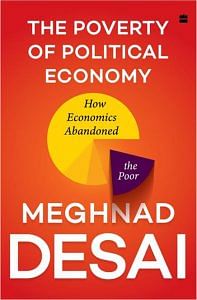The throne of economics travelled across the Atlantic at the end of World War II. The US was the new hegemon and, like all new hegemons, established a total dominance quickly in everything, including the ‘Keynesian Revolution’ (as a book was labelled by twenty-four year-old American economist Lawrence Klein, who got his PhD at MIT). Keynes himself died in 1946 after working through the war. The Cambridge (England) Keynesians were outraged by the idea that the new proselytizers of the revolution were these (say it softly, uncouth) Cambridge (Massachusetts) Keynesians. These Americans had not even ‘read Economics’ at Cambridge, England (the elite read at Cambridge, the rest have to be taught, as they cannot just ‘read’ by themselves). What did they know of the subtlety of British economic discourse?
But Alvin Hansen of Harvard, with his Scandinavian roots, was a great preacher. He was also a great simplifier and made Keynes’s new theory so simple that it all boils down to one diagram— the Keynesian Cross. Much worse was to follow. The younger Americans were even worse, reducing Keynes’s theory to a small set of equations! No elegance, no subtlety.
The new aspirant to the throne of economics was Paul Samuelson, the enfant terrible who graduated from Harvard in his early twenties with a PhD published soon after, modestly titled The Foundations of Economic Analysis. Born in the Midwest in 1916, Samuelson was not only an outstanding theorist but left no one in any doubt that he knew, and that they better agree with him, that he was the best. Even in the 1990s, as I can attest, his boyish enthusiasm for his latest economics article had not diminished.
(In the late 1990s, I reviewed a book which was a Festschrift for Richard Goodwin. Goodwin had been a Fellow of Peterhouse at Cambridge, and while a man of few publications, was one of the most creative. I was lucky enough to get to know him. In the book was an article by Samuelson explaining catastrophe theory which was, for reasons hard to explain, all the rage in those days. I said in my review that the article was the best in the collection.
I soon received a letter from Samuelson thanking me for my praise. He explained that whatever he wrote had to satisfy not only the editors of the publication but his own exacting standards as he had to include it in his Collected Scientific Papers!
I was impressed that he treasured every word of praise without worrying about who it came from. This was some thirty years after he had won the Nobel Prize.)
Like Marshall, Samuelson systematically went about establishing his position. He knew he was the new Marshall. Harvard had gathered a pool of economists from around the globe between the world wars. Frank Taussig, Gottfried Haberler and Joseph Schumpeter were well known around the world. America had other stars. Irving Fisher at Yale and Frank Knight at Chicago. George Schultz, a pioneer in the fledgling science of Econometrics who died young, established quantitative demand analysis on a firm foundation. Oskar Lange, a young Polish Economic theorist, was at Chicago, which also housed The Cowles Foundation for Research, mainly in Econometrics and Mathematical Economics.
Samuelson faced discrimination at Harvard as he was Jewish. In those days, you could breathe antisemitism in the air. He quit the prestigious Harvard Economics Department to establish its rival across the Charles River, at the Massachusetts Institute of Technology. Soon, he gathered around himself an amazingly talented pool of economists, many of them his own doctoral students. In 1948, he published his textbook, Economics: An Introduction. It was not a weighty, sonorous treatise starting from Creation. It was breezy, beautifully printed, easy to read and profusely illustrated (later with multiple colour diagrams). It was meant to disseminate a core syllabus in economics across America. Thousands of copies were sold over several subsequent editions. Economics was Samuelson, Samuelson was economics.
The GIs back from the war were going to college under a generous scheme. There was a demographic surge in any case. Jobs were plentiful (claimed as an achievement of New economics). The US was, even by 1948, geared up for the Cold War and knew that the battlefield would not only be science and technology and quantitative tools but academic research as well. Research & Development had won the war (the atom bomb was an outstanding achievement of theoretical physics and innovative engineering). The US enshrined these discoveries by founding a Research and Development (RAND) Corporation as a permanent think-tank. The new branch of economics, Mathematical economics and econometrics, became the favourite recipient of research funding.
Samuelson was very much a proselytizer of Keynesian economics, along the lines of his teacher Alvin Hansen. But he added some elegant maths to (what came to be known as) the Hicks-Hansen Keynesian model. It eschewed all theological textual disputes as to what Keynes really meant in the General Theory. The Circus back in the UK was spending enough of its time on it. Keynesianism had to deliver full employment by spending enough government revenue to keep aggregate demand at the level where it would guarantee full employment. Economics now had the tools to advise the government on the level of expenditure and predict the total revenue it would raise. Samuelson was the cheerleader for Keynesian economics in academia and the portals of government.
The English have a well-knit elite, the Landed Peerage, sitting in Parliament. Their younger sons, active in government and industry after a journey through public schools (Eton, Harrow Winchester) and Oxford/Cambridge, cultivate the middle-class intelligentsia they meet during their university sojourn (where it was fashionable for them to just barely pass or even fail and leave honourably) and establish firm ties. Keynes’s path is exemplary. He ended up as Lord Keynes, but that was special. As an unequal society unthreatened by change, the English are relaxed about the middling classes.
America is ostensibly an egalitarian society (of course, with the exception of women and Black, Asian and Native Americans). Status mobility is possible but has to be maintained by ferocious hard work against competition from all around. There is a small sliver of privilege, an exclusive club mainly on the east coast, but entry is barred and requires serious wealth. There is also ferocious partisanship in politics: though substantial ideological differences between the parties are few, Meritocracy is an American cultural achievement.
 This excerpt from Meghnad Desai’s The Poverty of Political Economy: How Economics Abandoned the Poor has been published with permission from HarperCollins.
This excerpt from Meghnad Desai’s The Poverty of Political Economy: How Economics Abandoned the Poor has been published with permission from HarperCollins.



